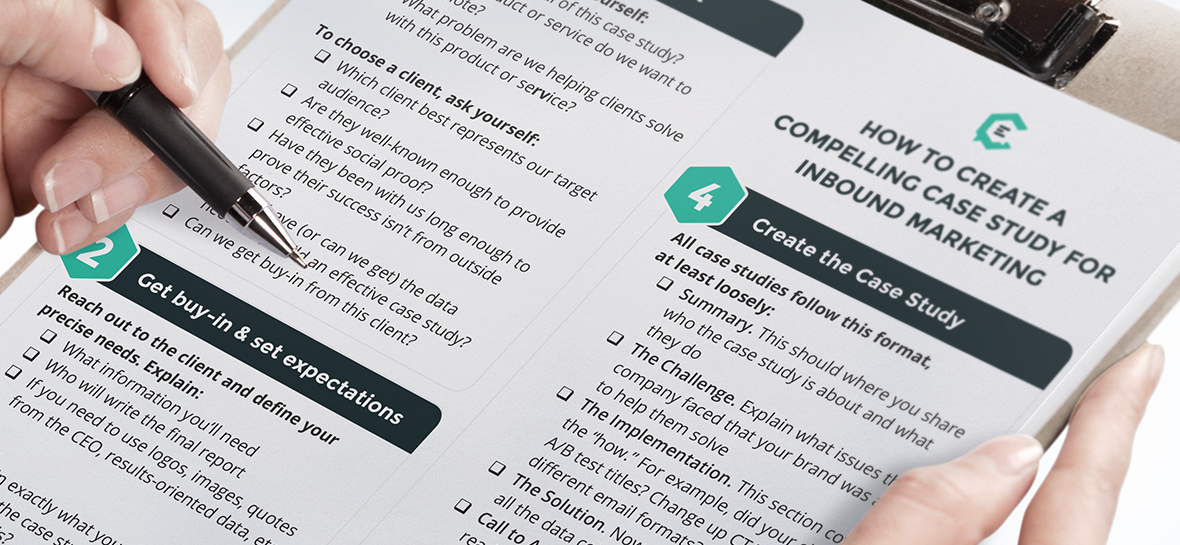People love a good story. Stories educate us; they entertain us; they help us bond with each other. Storytelling has even been vital to our survival as a species, according to Mother Nature Network.
And it’s our love of stories that makes case studies so successful. A case study takes flat, boring data and creates a narrative around it to demonstrate your point. They offer detailed, real-life examples of how you were able to meet your clients’ needs in a story-like fashion that draws people in.
Let’s get into why your brand should be creating case studies and then look at step-by-step instructions on how to do that.
>> Download a Printable Checklist: How to Create a Case Study for Inbound Marketing
4 reasons your brand should create a case study
- The story format makes the information easier for people to digest. Boring data sheets end up in the bottom of your email inbox, unread.
- Case studies position your brand as an expert in your niche. Check out this case study done by Yoast for OptinMonster. His study details how he added 10,000 email subscribers in just one month. That article has over 1,000 shares on Facebook alone — which means 1,000 or more people will now think of OptinMonster when they go to grow their email list.
- They enable you to prove your marketing claims. Which are you more likely to trust? “Our tool will help you improve your conversion rate” or, “Here’s how our tool helped Company XYZ boost their conversion rate by 65 percent.”
- Case studies earn far more links. Using Moz’s Open Site Explorer tool, I discovered that this case study by Moz earned 1,801 total links, while this post earned zero external links. Both are about link building; both were written by the same writer. They were published just one day apart. The difference? One was a case study, and one was not.
Case studies make for great middle- and bottom-of-the-funnel content. Keep in mind, you can do internal case studies (looking at your own data) or external studies (looking at how clients using your product or services have performed). This article will focus on external studies.
Now let’s get to the step-by-step instructions on how your brand can create a killer case study to use as part of your inbound marketing efforts.
Step 1. Choose a topic & client
The ideal topic for your case study depends upon what your brand does and who your clients are. Ask yourself:
- What is the goal of this case study?
- What product or service do we want to promote?
- What problem are we helping our clients solve with this product or service?
Once you have chosen the topic, you need to select a client that helps you best illustrate your topic. These questions will help you determine whom to include:
- Which client best represents our target audience?
- Are they well-known enough to provide effective social proof?
- Have they been with us long enough to prove their success isn’t from outside factors?
- Do we have (or can we get) the data needed to build an effective case study?
- Can we get buy-in from this client?
Step 2. Get participant buy-in & set expectations
After you have chosen the topic and an ideal client, you need to ask the client if they’re willing to participate. This is the time to set clear expectations, which helps ensure the project is completed on time and minimizes confusion.
Start by reaching out to the involved parties and define your precise needs. Explain what information you’ll need, who will write the final report, if you need to use logos, images, quotes from the CEO, results-oriented data, etc. Here is an example of a case study pitch letter:
Hi Pamela,
I am Danielle, the marketing director over at EmailsRUS.
Our team is working to create a compelling case study to show other brands how they can improve their bottom line by using EmailsRUS. We would like to ask you to partner with us on this study.
The case study would be an in-depth look at how using our platform helped your brand not only improve your open rate, but also increased CTR and your bottom line.
Inclusion in our case study will highlight your brand to our 1m+ monthly unique readers on our blog and our 174K social media followers through a blog post, a downloadable case study, and an aggressive social media campaign. Here are a few other stats:
- Our last case study received 2,500 downloads in the first month
- On average, our blog posts receive 800 reads in the first week
- We have budgeted $500 in social promotion for this case study
Interested in participating? Here is what we would need:
- Your email open rates data from 1/2016- 6/2016
- Data from A/B testing you performed during the same period (this includes what you tested and how each test performed)
- Data on email CTR
- 3 logo files in sizes 640 X 640 with permission to publish
- A statement from CEO John Black about what challenges your email program faced, how you were able to solve that problem, and how improving email rates has affected your brand’s growth (we will send you an interview to make it simple)
- Any additional data that shows how EmailsRUS solved your email challenges
- A headshot of John Black in 640 X 640
We need this information by 10/31 to hit our target publish date of 12/1.
That’s it! We will take care of analyzing the data, writing and publishing the case study. We will also provide you with a rough draft for approval on 11/20, two weeks before publishing.
I truly believe this case study will be a win-win for both our brands.
Please let me know if you are interested in participating by EOD Friday. If you’ve got more questions, feel free to ask.
Danielle Doe
Marketing Director, EmailsRUS
A few notes for crafting an effective case study pitch letter:
- Explain clearly, in as few words as possible, exactly what you need
- Position the case study as a win-win for both brands
- Make it easy for them (don’t make them think!)
Step 3. Collect relevant data

Once the requested information has been collected, the team lead will need to analyze the data and determine if you have all the information required. If more data is required, contact the client and be very specific about the information you need.
Step 4. Create the case study
Now that you have all the data, it is time to write the case study, create all the supporting graphics and lay it out in a PDF format. If you don’t have a graphic designer on staff, you can use free tools or hire a freelancer. We will talk more about the free tools you can use at the end of this section.
All case studies follow this format, at least loosely:
- Summary. This should where you share who the case study is about and what they do. Think of this as introducing the character of your story. Make sure the reader cares about their success.
- The Challenge. In every good story, the main character faces some sort of challenge. This is where you should explain what issues the company faced that your brand was able to help them solve.
- The Implementation. This section covers the “how.” For example, did your client A/B test titles? Change up CTAs? Test two different email formats?
- The Solution. Now you share the results of all the data collected. Don’t just take the data at face value, but take the time to analyze it and explain what different variables might have caused changes in the data. Perhaps sales increased by 150%, but it also coincided with their annual sale. You will need to consider the increase in last year’s sales during the same time period.
- Call to Action. What do you want readers of the case study to do? Read an in-depth guide? Sign up for a free trial? Live chat with support staff? This section should be brief and to the point.
Now the writer/project lead takes all the info and creates clear, compelling copy with short, strong points and quotes, images and graphics (and in some cases, video) sprinkled throughout.
Don’t forget: The content needs to be edited by a professional editor before it goes live. This is non-negotiable!
Tools for Creating Compelling Case Studies

- Images: PicMonkey
- Infographics: Canva’s Drag and Drop Infographic Creator
- Graphs: Rapid Tables or chartgo
- Video: Avidemux (Windows or Mac) or wevideo (browser, iOS, or Android)
- Create PDF: freepdfcreator.org
Step 5. Distribute your study
Once you have completed your case study and received approval from all parties involved, it is time to distribute it. Your exact plan will depend on your brand’s strengths, but remember this: The target audience for case studies is interested prospects at the middle or bottom of the funnel. You don’t distribute them in the same way you would top-of-the-funnel content, such as a blog post. Instead, you can:
- Publish on your website
- Arm your sales team to send to prospects
- Use in sales presentation decks
- Print for leave-behinds at sales meetings

Ready to start reaping these benefits and create your own case study? Download our printable checklist, “How to Create a Compelling Case Study for Inbound Marketing.”






